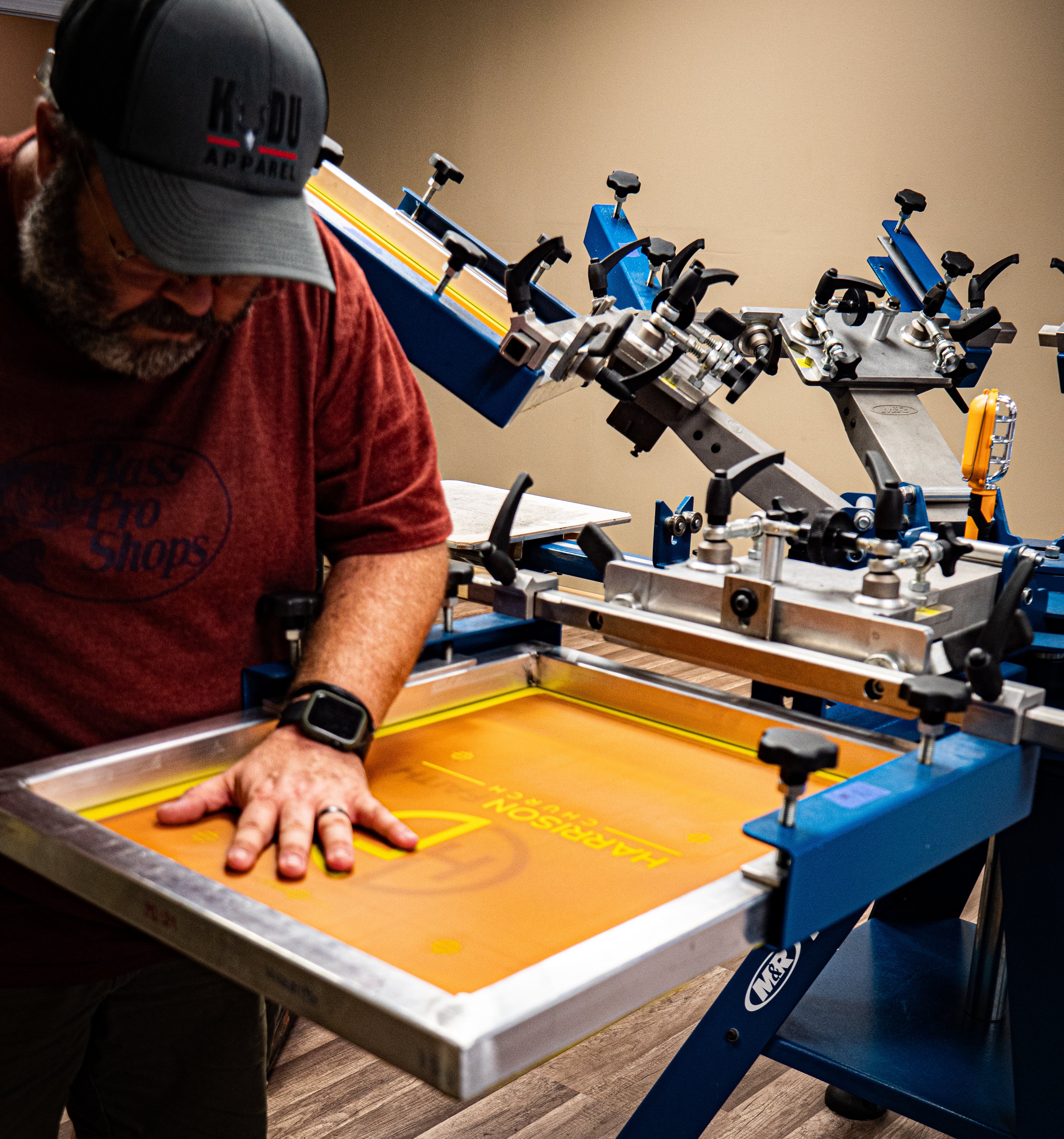Detailed Silk Screen Printing for Custom Art Apparel
Wiki Article
Screen Printing Uncovered: Whatever You Need to Understand About Tee Shirt and Garment Printing Techniques
Screen printing is a remarkable technique that integrates art with technique, using countless opportunities for imagination. Ready to check out the vital components that make screen printing an art form?
The Essentials of Screen Printing: Just How It Works
When you plunge right into screen printing, you'll uncover it's both an art and a scientific research. At its core, display printing includes creating a stencil, or screen, that enables ink to pass via just in certain locations.Next, you'll blend your inks and prepare your printing surface area. Placement the display over the textile, then use a squeegee to push ink through the display onto the garment. This process calls for precision, as you want clear, dynamic prints. After printing, you'll heal the ink with warm, ensuring it complies with the material and lasts with washes. Each action is crucial, and grasping them will certainly elevate your screen printing skills, transforming simple garments into special, meaningful items.
Kinds Of Display Printing Techniques
Once you understand the essentials of screen printing, it's time to discover the numerous methods that can raise your designs. One prominent technique is conventional screen printing, where ink is pressed with a stenciled screen. This strategy is terrific for vibrant, vibrant shades. There's water-based ink printing, which uses a softer feel and is environment-friendly, but it requires a various strategy to treating.One more option is plastisol printing, understood for its toughness and vibrant colors, making it a favored for lots of brand names. Experiment with halftone printing to create gradient impacts and complex styles.
Vital Tools for Screen Printing
To accomplish stunning outcomes in screen printing, having the appropriate tools is fundamental. You'll require a durable display printing framework, which holds the mesh that moves your layout onto the garment. Next, invest in high-grade squeegees; these are essential for applying ink uniformly throughout the screen.Selecting the Right Inks and Products
When choosing inks and products for screen printing, you need to take right into account the kind of ink that works finest for your project. Consider fabric compatibility to assure your designs look last and great long. Check out environment-friendly ink alternatives to make your printing procedure more sustainable.Kinds Of Screen Inks
Selecting the ideal screen ink is necessary for attaining dynamic, resilient prints that satisfy your project's demands. There are numerous kinds of screen inks to analyze. Plastisol ink is preferred for its convenience and ease of use, offering outstanding shade opacity on dark materials. Water-based ink, on the other hand, provides a softer feeling and is eco-friendly, making it ideal for those wanting to decrease their ecological influence. Discharge inks get rid of color from the material, resulting in a soft, vintage look but need certain handling. Lastly, specialty inks, such as metallic or glow-in-the-dark, can add one-of-a-kind results to your styles. Assess your task requirements and select the ink that aligns ideal with your preferred end result.
Textile Compatibility Factors To Consider
Understanding fabric compatibility is crucial for attaining top quality screen prints, specifically given that various products respond uniquely to numerous inks. When picking inks, think about the material kind-- cotton, polyester, or blends. For cotton, water-based inks function well, using softness and breathability. Polyester, on the other hand, often requires plastisol inks for better attachment and lively colors. You may need to utilize a combination of both types if you're printing on blends. Constantly test your inks on sample material to ensure they stick effectively and keep shade stability. In addition, bear in mind that textile weight and appearance can influence the last result, so selecting the best ink and product combination is vital for your task's success.Eco-Friendly Ink Options
Environment-friendly inks are becoming a popular selection for display printers that intend to minimize their environmental influence while keeping quality. When choosing inks, take into consideration water-based inks, which are much less dangerous and easier to cleanse up contrasted to typical solvents. These inks bond well with textiles, supplying lively outcomes without hazardous chemicals. You might also check out eco-solvent inks that utilize less unpredictable natural compounds (VOCs), making them a safer option for both your wellness and the world.Furthermore, seek inks made from renewable energies, such as soy or vegetable-based alternatives. By picking the ideal inks and products, you'll not only develop sensational layouts however likewise add to a more lasting printing procedure. Make the switch, and your prints will show your dedication to the setting!
Preparing Your Style for Screen Printing

Submit Style Demands
To guarantee your layout looks dynamic and sharp on textile, you'll need to pay close focus to submit format needs for screen printing. Make certain your design has a transparent background to stop unwanted white edges on your prints. Keep shade settings in mind; CMYK is standard for display printing, so transform your RGB develops appropriately.Shade Splitting Up Techniques
Color splitting up is a vital step in preparing your style for display printing, and mastering it can substantially boost your print quality. You'll require to damage your design into specific colors, as each shade needs a different display during printing. This accuracy not only guarantees precise color depiction yet likewise enhances the printing process.Resolution and Size
Achieving the very best lead to display printing starts with guaranteeing your layout has the ideal resolution and size. Ideally, your art work must go to the very least 300 DPI (dots per inch) for sharp, clear prints. Your last item might look pixelated and unprofessional. if you make use of reduced resolution.When it pertains to dimension, think about the dimensions of your print location. Design your artwork to match the last print dimension, preferably producing it in the real measurements you'll be publishing. In this manner, you'll avoid any type of unexpected scaling issues.
Constantly check your style in both vector and raster styles. Vector graphics can be scaled without losing quality, making them suitable for display printing. Preparing appropriately will guarantee your design looks impressive on every garment!
Step-by-Step Display Printing Refine
Display printing is a dynamic procedure that permits you to produce lively styles on different surfaces. To obtain started, you'll need a display, solution, and your selected ink.After rinsing the unexposed emulsion, your display is all set. Establish it up on your printing surface and align your garment beneath it. Put ink onto the display and utilize a squeegee to push the ink through the pattern onto the textile. Raise the screen very carefully and allow the print dry. Lastly, treat the ink making use of warmth to assure resilience. That's it! You've efficiently display printed your layout.
Tips for Effective Display Printing Projects
While you're diving right into your display printing jobs, bear in mind that prep work is vital to success. Beginning by collecting all your materials-- inks, displays, mops, and garments. A tidy office aids protect against unwanted mistakes, so clean before you begin.Following, verify your artwork is high-resolution and correctly sized for your garment. Test your display for proper direct exposure and clean it extensively to prevent smudges. When blending your inks, follow the supplier's guidelines to achieve the appropriate uniformity.
Throughout printing, apply even stress with your squeegee for constant outcomes. Do not rush; take your time to confirm each print fulfills your requirements. After printing, allow your garments completely dry completely before handling or packaging them.
Finally, constantly maintain a sample of your benefit future referral. By doing this, you can analyze your development and improve your strategies in time. Pleased printing!

Frequently Asked Questions
The length of time Does It Take to Set up a Display Printing Job?
Establishing a screen printing job typically takes around thirty minutes to an hour. You'll prepare the screens, mix inks, and adjust journalism. The time varies based on complexity and experience, so stay organized!Can I Print on Different Material Keys In Making Use Of the Exact Same Strategy?
Yes, you can print on different material types using the exact same technique, but you'll need to readjust your inks and settings. Some fabrics absorb ink in different ways, so experimenting warranties the most effective results for every material.What Prevail Mistakes to Prevent in Screen Printing?
When display printing, prevent common errors like using the incorrect ink, disregarding appropriate exposure times, or avoiding pre-press checks. Always examine your arrangement and maintain tidy screens to ensure quality results each time.Exactly How Can I Correctly Clean and Preserve My Screen Printing Devices?
To effectively clean and preserve your display printing equipment, you need to frequently wash screens with proper solvents, check mops for wear, and ensure all devices are saved dry and dust-free. Uniformity avoids costly repairs and enhances efficiency.Is Display Printing Eco-friendly Compared to Other Approaches?
Display printing can be extra eco pleasant than various other techniques, specifically if you make use of eco-conscious products and water-based inks. By picking lasting materials and methods, you reduce waste and minimize your effect on the world.Display Printing Uncovered: Whatever You Required to Know Regarding Tee Shirt and Garment Printing Strategies
At its core, display printing involves creating a stencil, or display, that allows ink to pass with just in particular locations. Position the screen over the textile, then use a squeegee to silk screen printing push ink via the screen onto the garment. One popular method is conventional display printing, where ink is pressed via a stenciled display.When picking inks and products for display printing, you require to take right into account the kind of ink that functions best for your job.
Report this wiki page